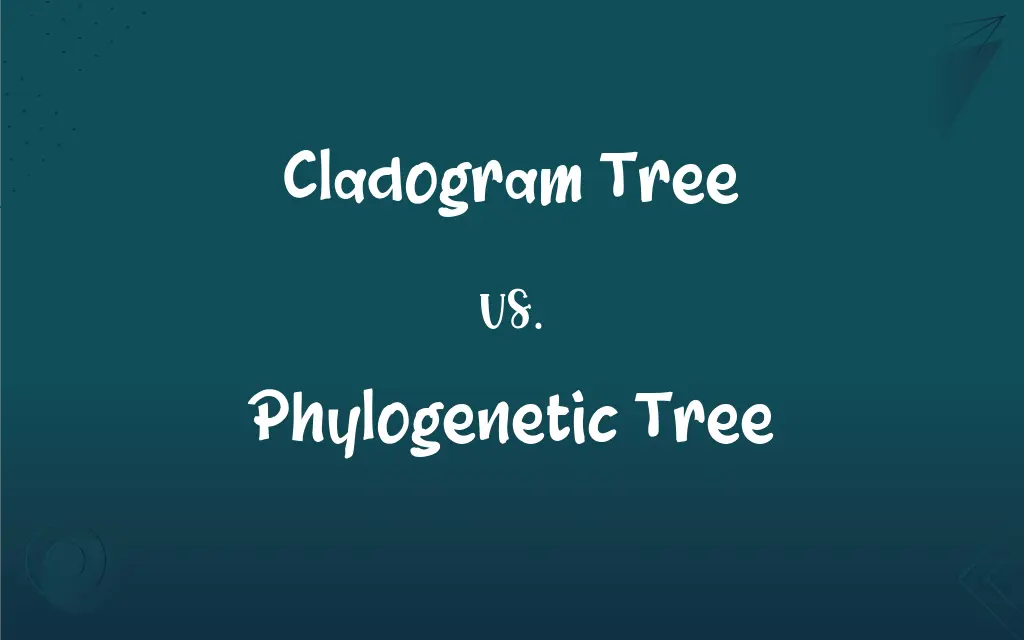Cladogram Tree vs. Phylogenetic Tree: What's the Difference?
Edited by Janet White || By Harlon Moss || Updated on October 20, 2023
A cladogram tree displays groups based on shared derived characteristics, while a phylogenetic tree depicts evolutionary relationships with branch lengths indicative of time or genetic change.

Key Differences
A cladogram tree is a diagram used primarily in cladistics, an approach to biological classification. On the other hand, a phylogenetic tree is a diagram that illustrates the evolutionary relationships between organisms.
In a cladogram tree, the focus is on grouping organisms based on shared derived characteristics, without necessarily showing evolutionary time or genetic distance. Meanwhile, a phylogenetic tree goes beyond grouping; it seeks to represent the time or genetic changes along its branches.
A cladogram tree often looks similar to a phylogenetic tree in its branching structure, but the lengths of its branches don't have a consistent meaning. In contrast, the branch lengths in a phylogenetic tree are typically proportional to the amount of genetic change or time.
When looking at a cladogram tree, the primary emphasis is on the nodes (or branching points) which signify a common ancestor that had a specific derived trait. In a phylogenetic tree, while nodes also represent common ancestors, the lengths of branches give a sense of the time elapsed or genetic divergence.
Both the cladogram tree and the phylogenetic tree are vital tools in biology. However, while the cladogram tree is more about discerning patterns of shared characteristics, the phylogenetic tree offers a broader picture, encompassing evolutionary history and often genetic distances.
ADVERTISEMENT
Comparison Chart
Primary Purpose
Shows shared derived characteristics.
Displays evolutionary relationships.
Branch Lengths
Not indicative of time or genetic change.
Often represent time elapsed or genetic divergence.
Focus
Nodes (branching points) for common traits.
Both nodes for common ancestry and branch lengths.
Evolutionary Time
Not directly represented.
Commonly represented by branch lengths.
Use in Classification
Primarily in cladistics.
Across various evolutionary biology contexts.
ADVERTISEMENT
Cladogram Tree and Phylogenetic Tree Definitions
Cladogram Tree
A cladogram tree emphasizes branching points without showing time or genetic distance.
He was careful not to misinterpret the branch lengths on the cladogram tree.
Phylogenetic Tree
A phylogenetic tree displays the evolutionary relationships between species.
By studying the phylogenetic tree, he could trace the lineage of various primates.
Cladogram Tree
A cladogram tree is a tool in taxonomy that doesn't depict evolutionary time.
While analyzing the cladogram tree, she noted that it didn't give insights into when the species diverged.
Phylogenetic Tree
A phylogenetic tree can be built using molecular data or morphological traits.
Using DNA sequences, she constructed a detailed phylogenetic tree of birds.
Cladogram Tree
A cladogram tree's branches signify shared traits, not the amount of change.
Unlike some other trees, the branches on the cladogram tree were not about genetic differences.
Phylogenetic Tree
A phylogenetic tree is a diagram that often indicates genetic change or time on its branches.
The longer branches on the phylogenetic tree suggested significant genetic divergence between species.
Cladogram Tree
A cladogram tree illustrates the grouping of organisms based on shared derived features.
The cladogram tree showed that birds and dinosaurs shared certain anatomical features.
Phylogenetic Tree
A phylogenetic tree showcases the historical connections among organisms.
The ancient connections of amphibians and reptiles were evident on the phylogenetic tree.
Cladogram Tree
A cladogram tree is a visual representation of cladistic analysis.
For her project, Maria drew a cladogram tree to highlight shared characteristics among reptiles.
Phylogenetic Tree
A phylogenetic tree provides insights into the common ancestors of different species.
The node on the phylogenetic tree revealed a common ancestor for both cats and dogs.
FAQs
Is a cladogram tree used outside of cladistics?
While primarily a tool in cladistics, cladogram trees might be used in broader contexts but with understanding of their limitations.
What do the nodes in a phylogenetic tree signify?
Nodes in a phylogenetic tree typically represent common ancestors.
How is a phylogenetic tree different from a cladogram tree in terms of branch length?
In a phylogenetic tree, branch lengths often represent time or genetic change, whereas in a cladogram tree, they don't have a consistent meaning.
What's the primary tool for showing evolutionary time in a graphical form?
The phylogenetic tree, especially when branch lengths represent time, is the primary tool.
What does a cladogram tree mainly represent?
A cladogram tree represents groups based on shared derived characteristics.
Can a phylogenetic tree be used to estimate when two species diverged?
Yes, if the phylogenetic tree's branch lengths represent time, it can estimate divergence times.
Can a phylogenetic tree show the genetic distance between species?
Yes, if built using genetic data, a phylogenetic tree can reflect genetic distances.
Can a cladogram tree show evolutionary time?
No, a cladogram tree doesn't directly depict evolutionary time.
Is a cladogram tree typically used for molecular studies?
Cladogram trees can be used with molecular data but don't indicate the amount of molecular change like some phylogenetic trees might.
What kind of analysis typically results in a cladogram tree?
Cladistic analysis, which groups organisms based on shared derived features, typically results in a cladogram tree.
Why might someone critique a cladogram tree's depiction of evolutionary relationships?
A critique might arise because a cladogram tree doesn't show evolutionary time or genetic distance, only shared derived traits.
Do both the cladogram tree and phylogenetic tree depict common ancestry?
Yes, both types of trees show points of common ancestry, but they represent other aspects differently.
How is ancestry represented on a phylogenetic tree?
Ancestry is represented by the nodes or branching points on a phylogenetic tree.
Can both cladogram trees and phylogenetic trees be used in taxonomy?
Yes, both can be used in taxonomy, but they offer different insights and representations.
Are cladogram trees and phylogenetic trees types of evolutionary trees?
Yes, both are types of evolutionary trees but with different focuses and representations.
How do researchers decide between using a cladogram tree or a phylogenetic tree?
The choice depends on the research question and data, with cladograms emphasizing shared traits and phylogenetic trees emphasizing genetic or time-based relationships.
Do all branches on a cladogram tree have the same length?
In many cladograms, branches are of equal length, but this doesn't convey genetic change or time.
How is genetic data utilized in a phylogenetic tree?
Genetic data, like DNA sequences, can be used to infer evolutionary relationships and construct a phylogenetic tree.
What is the main focus of the branches in a cladogram tree?
In a cladogram tree, the focus is on the nodes, or branching points, which signify shared derived traits.
What kind of data can be used to create a phylogenetic tree?
Both molecular (like DNA) and morphological data can be used to construct a phylogenetic tree.
About Author
Written by
Harlon MossHarlon is a seasoned quality moderator and accomplished content writer for Difference Wiki. An alumnus of the prestigious University of California, he earned his degree in Computer Science. Leveraging his academic background, Harlon brings a meticulous and informed perspective to his work, ensuring content accuracy and excellence.
Edited by
Janet WhiteJanet White has been an esteemed writer and blogger for Difference Wiki. Holding a Master's degree in Science and Medical Journalism from the prestigious Boston University, she has consistently demonstrated her expertise and passion for her field. When she's not immersed in her work, Janet relishes her time exercising, delving into a good book, and cherishing moments with friends and family.































































